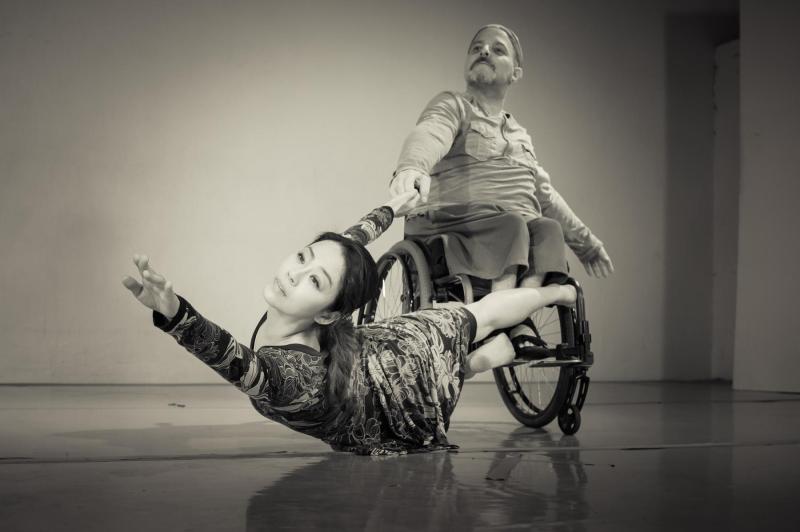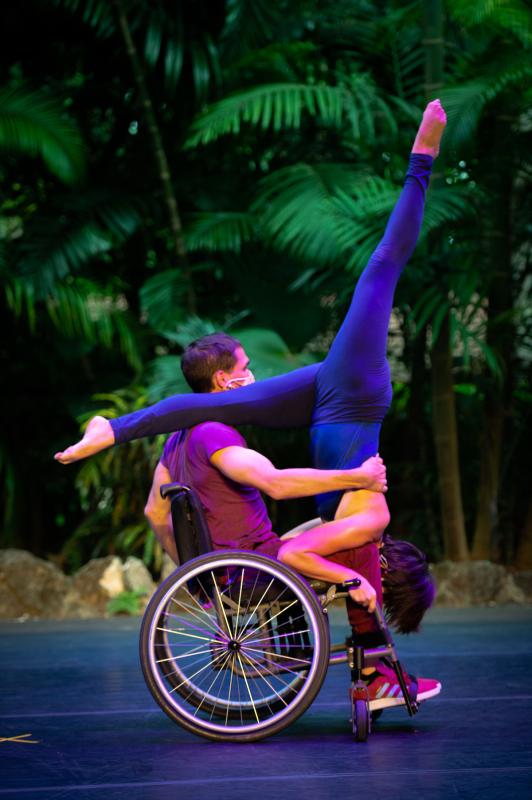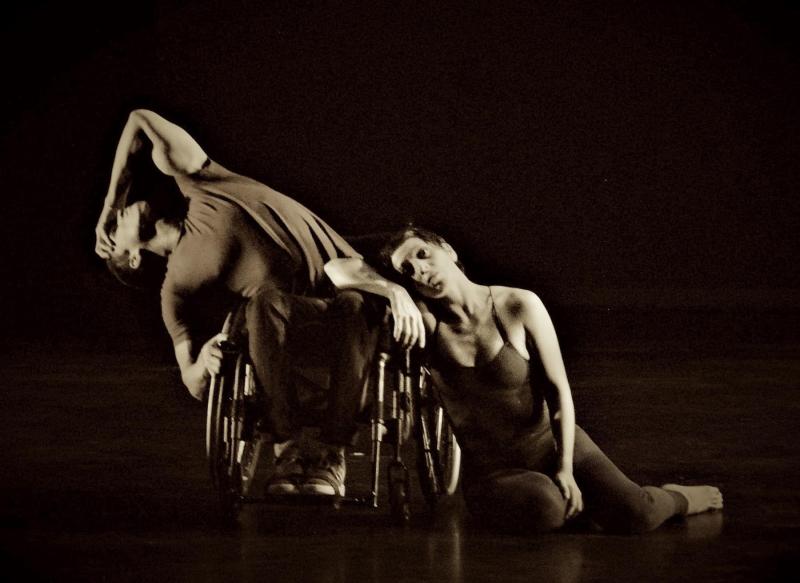Grant Spotlight: Karen Peterson and Dancers

KPD company members, Sun Young Park and Adam Eckstat, reach through space, using each other as support, from Karen Corash’s choreography, “Samsara” which premiered at the Miami Dade County Auditorium in 2021. Photo by Lisa Nalven
Located in Miami, Florida, Karen Peterson and Dancers (KPD) is dedicated to the advancement of physically integrated dance. Offering inclusive workshops and professional contemporary dance performances, KPD is the only dance company in the southern region beyond Georgia that operates in the physically integrated dance field. The company has toured their productions in New York, Ohio, Georgia, and Washington, DC. Internationally, KPD has engaged in performance residencies and cultural exchanges, fostering the development of new works in São Paulo, Brazil; the Edinburgh Festival Fringe in Edinburgh, Scotland; and the American Choreographers Showcase in Barcelona and Madrid, Spain. KPD’s reach expands to working with over 5,000 teenagers with special needs in Miami-Dade Schools, empowering them through the art of dance and promoting inclusivity in the performing arts. In 2019, KPD was honored as "Best Dance Company" by Miami New Times.
The road less travelled will often lead to journeys unexpected, and that is exactly what happened for the visionary behind KPD—Founding Artistic Director Karen Peterson Corash—who has been widely acclaimed for her choreographic leadership. As Corash described, “My original intention was solely artistic, but throughout my 32 years of creating and presenting workshops and dances, I have helped to demystify and challenge disability perceptions in a way that I did not originally set out to do.” Throughout her career, Corash has earned numerous awards, including the Lifetime Achievement Award in 2011 from the Mildred Levenson Dance Foundation and a "Queen of the Arts” Award from the Miami Herald in 2014.
In May 2023, the organization received an Arts Endowment grant to support the work of the fifth annual Forward Motion Dance Festival and Conference, which will bring together dance companies from around the world for a three-day event featuring physically integrated performances, community engagement, and educational opportunities.
Corash spoke with us about what inspired her to establish KPD, the upcoming Forward Motion festival and conference, and the vital role of dance in building shared human experiences.
NEA: What inspired you to establish Karen Peterson and Dancers? What community need did you believe the organization could address?
KAREN PETERSON CORASH: I was drawn to contact improvisation, in the early 1990s, when workshops began to offer movement opportunities to individuals with disabilities. I witnessed empty wheelchairs and walkers placed by the wall, and bodies with and without disabilities moving as one. My thinking about who could dance and who could not was inspired by this new experimental dance form, offered by Axis Dance Company and Alito Alessi on the west coast of the United States. At that time, it was called physically challenged or mixed-ability dance. Improvisation forced me to think about choreography and the way steps and movement phrases were often placed on bodies. Contact improvisation seemed fresh, free, inclusive, authentic, and in-the-moment. My curiosity was engaged. This new way of dance making guided me as I shared ideas with differently abled movers back in Miami. I envisioned a more complex, meaningful, heartful dance form where diversity, equity, and inclusion were built into the collaboration.
In 1991, I presented my first physically integrated trio at the New World School of the Arts and created 35 more choreographies after that. At the time, there was a need in the Miami community that was not being addressed. Adults and students with disabilities were not offered movement classes for recreation or creative expression, and I saw this as a window of opportunity for me to pursue.
NEA: Part of your organization’s mission is based on the “belief that through dance, we can better understand our common humanity by exploring and appreciating this impulse to move.” How does dance serve as a means of building shared human experiences and empowerment for all individuals?
CORASH: Dance is a tool that I have used for 32 years to bring differences together and create unity. Dance company members who intimately create and perform together are forced to understand the daily needs and challenges of individuals who use a wheelchair, cane, or walker. Dancers build empathy, compassion, awareness, tolerance, and a collective sense of humanity when they create physically integrated work together. This close, skin-to-skin experience often does not take place in other aspects of everyday life.
NEA: What makes KPD unique as a dance ensemble?
CORASH: I create dances that are built on the equal creative and performance participation of dancers with a variety of differences. After a dancer leaves the company, he or she is difficult to replace because of their unique contribution and the specific qualities they bring to the choreography. A dancer with cerebral palsy cannot be replaced by a dancer who has a spinal cord injury. A dancer who uses a power chair cannot be replaced by a dancer who uses a cane. Each dancer is empowered by the fact that they are irreplaceable unless the choreography is totally reworked.

KPD company members, Penelope Huerta and Jesus Vidal, in a supportive moment from “Lost and Found” performed at the Pinecrest Garden in 2021. Photo by Giorgio Viera
NEA: Can you describe the selection process for the company dancers?
CORASH: In the late summer, I hold an open community audition. Outreach tools we use include newsletter, social media, and through word-of-mouth communication. The job training takes place in the studio during the first few months to learn if the physical demands can be met by the dancer. In order to build trust and safety, I create a safe space in the studio. Dancers with disabilities often lack dance training or prior company experience, so I look for individuals who have a sense of physical exploration, curiosity and are willing to go beyond their comfortable boundaries. I often seek out athletes who have an injury. After two months, I know who is ready to make the deep commitment and who has a sense of their physical expression. The new dancers also must have a primary source of income apart from the KPD part-time artistic stipends, and their own mode of transportation.
NEA: What are some of the misconceptions or stereotypes surrounding dancers with disabilities, and how does your organization work to overcome them?
CORASH: Dancers with disabilities want to be expressive, want to make artistic contributions, want to have their voices heard and show that they are not vulnerable, weak, or incapable. They want to show what is unique to their physical abilities and feel important to the total choreographic vision.
Under my direction I build everyone’s confidence to let them know they can pursue the highest quality of work by supporting each other's strengths and vulnerabilities. I build teamwork, family, and community through the process of making the work. With the less experienced dancer, I give them the movement tools to bring them up to speed with the ensemble.
NEA: How does the collaboration between KPD dancers of all abilities challenge and redefine traditional notions of dance?
CORASH: Dancers with disabilities are introduced to the basic concepts of improvisation and contemporary dance so that the collaboration starts from a common place. All the dancers must have an understanding of space, time, energy, weight sharing, balance, support, and be fearless of touch. We learn to explore each other's bodies and personal devices, we challenge each other's expectations and boundaries, and we experiment with the new vocabulary that is being created by that specific group.
Successful collaborations take place when the organic movement of the disabled dancer is highlighted and then woven and shared with others. For example, the quality of arm movements from a dancer with cerebral palsy can be repeated, expanded, or enlarged in many different ways by utilizing the basic composition tools of dancemaking. This full integration and combination of different physical abilities moving as one redefines the notion of dance and challenges the audience's preconceived prejudices. This has changed over the years as more and more inclusive dance groups have found their way to the national stage.
Often, KPD audiences do not know what to expect during a performance, but 95 percent of our audiences describe our production[s] as “moving, emotional, striking, energetic, innovative, inspiring, beautiful, creative, thought-provoking, inventive,” as surveyed in our May 2023 program.
NEA: Can you give us a snapshot of what the upcoming Forward Motion Physically Integrated Dance Festival and Conference entails? What are the goals?
CORASH: The goals are to: provide performance opportunities to dance and music artists with neuro diverse and physical disabilities, and to unite them on stage as one; break down barriers and provide a positive message about overcoming physical and intellectual challenges; provide opportunities to dance artists and choreographers with disabilities; to inspire others by highlighting ability not disabilities; to provide a “true” community integration of live music and dance; and to use Forward Motion as a festival to share performances, movement ideas, methods of educational methodology, and shared fun under the umbrella of inclusive dance.
Program 1 will showcase European champion dancers, Paweł Karpiński and Magdalena Matusiak, World Cup winners of the International Wheelchair Para World Sport. They will perform their ballroom dance styles to the blues, rock, and jazz songs played and sung by the Spirit of The Goodwill Band musicians and singers. This unique live collaboration will showcase 20 dance and music artists with disabilities in recognition of inclusion and equity in the performance world.
KPD will balance and share the program with their unique contemporary dance style that we have developed over the last 30 years. Program 2, called New Voices, New Dance Makers, will highlight the work of choreographers with disabilities from around the country and will give them an opportunity to set new work on KPD and create solos to be played with the Goodwill Band. We are in the process of creating contracts for several choreographers with disabilities and Mark Travis Rivera will be our guest dance maker for KPD this season.
NEA: What are other ways in which the organization engages with the community?
CORASH: KPD has offered workshops, lecture demonstrations, and educational programs to Miami-Dade Public School students since 2006, to physical and recreational therapy students at the University of Miami and Florida International University, to hospitals and rehabilitation centers, [and] to festivals that celebrate inclusive dance. We also feature open rehearsals at the company’s 50-seat home, EXCELLO Dance Studio.

KPD company members, Penelope Huerta and Jesus Vidal, in “Lost and Found,” a pandemic tribute choreographed by Karen Corash at the New World School of the Arts Theatre in 2022. Photo by Simon Soong
NEA: What advice would you give to dance organizations who are looking to make dance education and training more accessible and inclusive for individuals with disabilities?
CORASH: Arts organizations in 10 countries abroad have reached out for the best practices of KPD and the disability and dance communities in South Florida understand inclusive dance because of my long-term commitment. Organizations who want to provide more accessible training to individuals with disabilities should seek out teachers, facilitators, or choreographers who have experience in the field. There are many teacher training programs throughout the country as well as independent individuals who work, teach, and can provide syllabi for reference. The organization should be made aware
that making education accessible is not a one-time event, but should be an ongoing commitment.
NEA: Complete this sentence. Disability representation in the dance community matters because…
CORASH: Dance provides the tools for instruction, collaboration, creation, and presentation and this artistic opportunity should be granted to everyone with diverse abilities.




